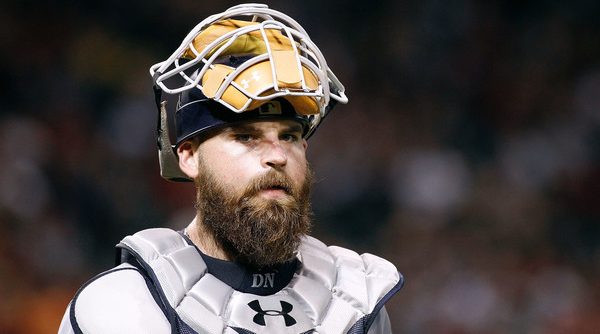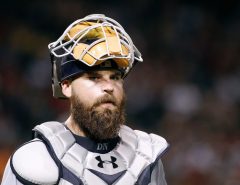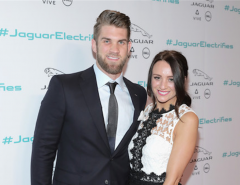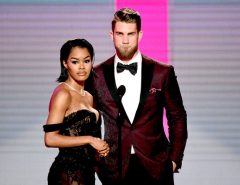Time is a flat circle, so it’s only fitting that Derek Norris is returning to DC. After the Nationals shipped him to Oakland as part of the deal that brought Gio Gonzalez to DC, Norris has been dealt back to the team that originally drafted him. In a deal announced Friday, the Nationals found a potential Wilson Ramos replacement in the former Padre Norris in exchange for Single-A pitcher Pedro Avila.
In a thin free agent market for catchers, the Nationals opted to go the trade route in a move that officially closes the door on Ramos’ career in DC. Norris is no Ramos, though. In fact, he was by some measurements the worst everyday hitter in baseball in 2016. But he doesn’t have to be Ramos. He only has to be an improvement on the duo of Pedro Severino and Jose Lobaton. He is set to be inexpensive in arbitration for 2017 and 2018 and came at the cost of only a young pitching prospect, so it’s not a crazy bet for the Nationals to make.
After three straight seasons of average to above average offensive production, Norris struggled immensely in 2016. He hit only .186/.255/.328 on the year, bad enough for a 55 wRC+, worst in baseball among everyday players. His strikeout rate spiked from around 20% to over 30% last season. His walk rate dropped to under 8%. He pulled the ball less than ever before. His swinging strike rate jumped as he made less contact on a per swing basis. In summary, it was a quick fall from grace for the former All Star.
That paints a pretty bleak picture of Norris as a hitter, but it won’t take much for Norris to be an improvement offensively over Lobaton or Severino, because the bar is set so low by those two. There are positive signs amidst the poor 2016 results that could point towards a bounce back season for Norris. He had a measly .238 BABIP last season, significantly below the .300 plus BABIPs he posted over the previous three seasons. Even though the batting average doesn’t show it, Norris still hit the ball hard in San Diego last year. His exit velocity has been consistent year over year. He continued to hit more fly balls and line drives and fewer groundballs. He still hit double-digit home runs amidst all his struggles. While he did swing and miss more in 2016, he wasn’t swinging at more pitches out of the strike zone so it’s not as if his plate discipline fell off a cliff along with his batting average.
That makes 2016 a perplexing year for Norris. It’s certainly possible that Norris is on the decline already. He struggled to make contact in 2016 and when he did, he wasn’t able to pull the ball with as much authority as he has done in the past. Those are usually signs of offensive decline. On the other hand, he was still hitting the ball hard and laying off pitches out of the zone. Perhaps Norris was hurt by playing so many games in Petco Park, a stadium that suppresses production on balls hit in the air. Perhaps Norris was just plain hurt, unable to pull balls because of physical limitations. The Nationals are certainly hoping it was a one-year blip for a previously productive offensive player.
Of course, offense is only a part of the game and defense matters, especially for a catcher. Norris has never been good at throwing out base stealers, with a career caught stealing rate of about 25%, just below league average. Some of that responsibility falls on his pitchers, and the Nationals pitching staff has done a decent job in the past of limiting aggressive base stealers. Ignoring the arm, Norris rates out as an above average pitch framer, although anecdotally he may not be a favorite of at least some pitchers. Compared to Lobaton and Severino, two of the top defensive catchers in baseball, Norris will represent a step down with the glove.
Norris didn’t come for free, of course. While his salary won’t cost the team a lot of money, he did cost a prospect: Pedro Avila. Avila wasn’t one of the Nationals top prospects, and he won’t end up in the upper echelon of the Padres minor leaguer rankings either. He has some promise, though. He throws hard and held his own with a sub-4.00 ERA in Single-A ball as a 19-year-old last year. But it’s a long journey for a 19 year old pitcher to reach the majors. He will have to learn how to pitch all the while trying to avoid injury. So the Nationals didn’t give up a nobody in order to acquire Norris, but the immediate cost is close to zero and the long term cost is most likely minimal.
In the end, the Nationals are hoping Norris will return to his old form at the plate and provide some much needed pop at the bottom of the order. Expect Norris to start the season splitting time with Lobaton while Severino gets regular at bats in the minor leagues. It may be hard to predict what Norris will look like in 2017. His 2016 was just so bad yet the projection systems anticipate a somewhat significant bounce back. Whatever the case may be on the field, Norris will, at worst, add another impressive beard to the Nationals’ stable of facial hair.
Tags: Derek Norris, Nationals, Nats, Pedro Avila, Washington Nationals, Wilson Ramos




Leave a Reply